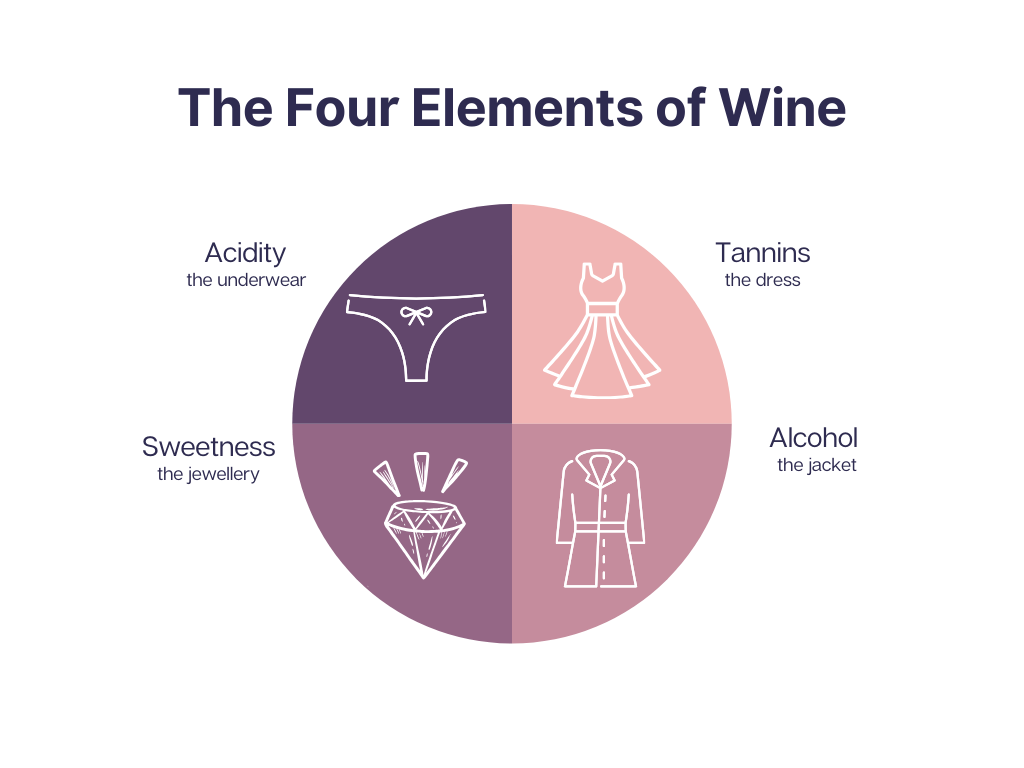
The 4 Essential Items of a Wine Wardrobe: A useful guide to understanding wine
Wine people often like to talk about wine with big words, and florid, important sounding language.
The problem is, a lot of this language is often completely lost on the rest of us – the normal wine drinker. Hearing a wine expert extol the virtues of a wine can leave many of us feeling like we don’t know a thing.
But what if I told you that the essence of tasting a wine is built on just four building blocks? Just like getting dressed in the morning, these are the four non-negotiable items that are required to complete an outfit. As soon as you know what these are you can pretty much talk about wine as well as anyone.
- Acidity
- Tannins
- Sweetness
- Alcohol
If you think about them like the building blocks of items that you wear to put a full look together, it becomes much easier to remember!

All wines are defined by these four elements. Get to know them by going through the descriptions below, and then taste as many different wines as you can with these four elements in mind.
Fabulous Tasting Tip: When tasting wines, make sure you take your time. Let the wine roll around your mouth so it touches all the parts of your tongue and cheeks.

1. Acidity – The Underwear
It feels sort of like…
Acidity is the va-va-voom of freshness and zing in your mouth. It’s a sensation most often felt on both sides of the tongue. Often, the acid creates a rush of saliva and gets your appetite going (which is why a fresh, acidic wine is so wonderful as an aperitif). The acid in wine can be super racy, or it can be dull.
It tastes like…
Once you can correctly identify acidity, then try and focus on the tastes inside that element. For white wines, you may taste citrus fruits like lemon, orange and grapefruit. Red wines with higher acidity – like pinot noir and sangiovese – may have flavours like sour cherries or tart raspberries.

2. Tannins – The Dress
It feels sort of like…
You feel the texture of tannins all over your mouth, and the right level and type of tannins can make or break a wine. They create a puckering or dryness in the mouth, similar to the feeling you can experience after taking a big gulp of black tea. When tannins are strong they can completely dry out your mouth and make your teeth feel furry. When they’re just right they add interest, texture and structure, either a raspy texture or a more polished, creamy feel.
Tannins also act as antioxidants, and help preserve wine (this is why reds, which have more tannins, tend to cellar better than whites). As wine ages, the tannins soften. Old reds tend to be less harsh than young ones.
It tastes like…
Tannins can contribute two characteristics to wine – astringency and bitterness. Bitterness results when the tannins are unripe (too young). When tannins are nice and ripe they taste smooth, round and velvety. The key to tasting tannins is to focus on the feeling in the mouth rather than the taste on the tongue.

3. Sweetness – The Jewellery
It feels sort of like…
The sweetness in wines comes naturally from the grapes, and so tends to have a fruity, grapey flavour (as opposed to a caramel or fairy-floss type sweetness). It’s most prominently tasted on the tip and middle of the tongue. But there’s more flavour than ‘feel’ for sweetness.
It tastes like…
Even when a wine is dry, there is perceived sweetness which comes from the fruit flavours present in the wine – so we use flavour descriptors like stone fruit (nectarine, peach), tropical fruit (passionfruit, pineapple), citrus (orange, grapefruit) or autumn fruit (apples, pears, quince). Red wines have red and blue fruit flavours like raspberries, blueberries, plums, cherries and blackberries.

4. Alcohol – The Jacket
It feels sort of like…
When a wine is high in alcohol (like a big, gutsy, Barossa shiraz for example) you can feel a warmth in your mouth – mostly on the middle and back of your tongue. If you’ve ever taken a nip or two of whisky or vodka, then you’ll know that burning sensation all too well: that’s the alcohol. The higher the alcohol, the higher the burn.
It tastes like…
It doesn’t really have a taste and therefore no flavour words used to describe it. However, alcohol and sweetness are connected. The more alcohol that is in a wine the sweeter it can be perceived on the palate.
Every outfit needs balance. And so does every wine.
Just like putting a look together in fashion, balance is key. That doesn’t mean you can’t make a statement! Winemakers use their skills and creativity to try and produce wines where all four of these elements are are in balance, whilst still telling a story through their wine.
As individuals we all have our own unique palate and preferences. Our mood, the occasion in which we’re drinking the wine, and the sort of food we’re eating with it can also affect our perception of each of these elements.
But if we can have this understanding of wine – that it’s made up of four key elements – it helps us know why we do or don’t like a wine, and what styles we prefer. For example, if you like soft, fruity wines then you can say you prefer wines with low acidity and high levels of fruit sweetness. So when you’re trying to order a wine you can give a good description and likely get something you like!

